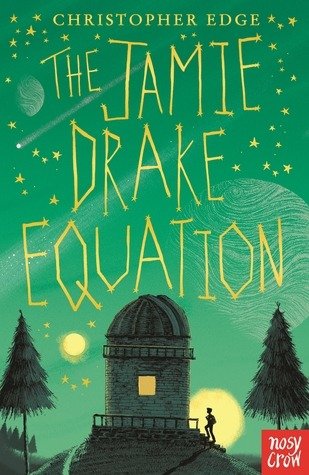A trip to the local library is a bit like going on a treasure hunt. You never know when you will find your next great read. Recently, one book in the kids fiction section caught my attention. The book was called “The Jamie Drake equation”. It was written by Christopher Edge. I’ve never heard that name before. But the book’s title promised an alien story and I was intrigued. I decided to give it a go. And you know what? I loved it! The author blended the “just right” amount of science into his story to make an exciting and educational book.
The plot
“The Jamie Drake equation” tells us a story of the Year 6 boy named Jamie Drake. His father is an astronaut working on the International Space Station. One day Jamie goes to the local observatory and meets an astronomer. He accidentally downloads the alien message on his phone. An important day comes when Jamie’s dad is scheduled to go on a spacewalk. His mission is to release the probes, that will travel to a faraway planet to search for life. Just as his father performs the spacewalk, the giant solar storm comes, trapping the astronaut outside the Station.
I am not going to tell you how this story ends. But I want to mention the episodes in the book in which fantastic science facts are hiding.
Science in the book
- Jamie meets an astronomer who tells him how scientists search for aliens. She mentions “The Big Ear” observatory, that in 1977 picked up a signal of supposedly alien origin. Indeed, there was The Big Ear Radio Telescope that 40 years ago received a strange signal. Astronomers nicknamed it “Wow! signal”. The signal came on the wavelength of 21 cm and lasted 72 seconds. It seemed to come from the constellation Sagittarius the Archer. The signal was exactly what we thought the alien call might look like. Unfortunately, we still don’t know where the 1977 signal came from or who sent it.
- The very same astronomer tells the boy about The Drake Equation. The Drake Equation is the very famous formula. It describes how many alien civilizations there are in our Milky Way Galaxy which we can possibly communicate with. Unfortunately, the equation does not give an exact number, as we cannot accurately estimate most of its parameters (such as, for example, “how many planets that could support life have actually developed life”).
- The main character receives an alien message on his phone in a form of number sequence. It looks like this: 0, 1, 1, 2,3, 5, 8, 13, 21…. He is later explained that these are Fibonacci numbers. Fibonacci numbers are the numbers of the Fibonacci sequence. Each following number is the sum of the two previous ones. Though it sounds like an abstract mathematical concept, we see the examples of Fibonacci numbers in nature. They are hidden in the order and arrangement of branches, leaves, flower petals and seeds. Are the Fibonacci numbers part of the bigger picture too?
- During his math test Jamie somehow mentally connects to the aliens. As he answers the last “create your own equation” question, he accidentally writes what turns out to be the first line of The Standard Model. The Standard Model is the mindblowing theory that describes all the elementary particles and how they interact. It is sometimes called “the theory of nearly everything”.
- The X-class solar flare has erupted while Jamie’s dad was outside the International Space Station. Solar flares are huge explosions on the Sun associated with the active regions. There are A,B,C,M and X solar flares, with A being the weakest and X the strongest. X- class flares cause problems to satellites, power grids, communications. They also might be dangerous to the astronauts. If the astronaut is caught outside his spaceship during the solar storm, he can get very sick! You can visit our mobile planetarium or your local observatory to learn more about Solar Activity!
- Astronaut Drake launches “Light Swarm Probes” that can travel almost as fast as the light. The prototype for the Swarm probes is the Starshot project. It is currently just the idea to explore space using nano probes on laser beam sails. The project is open to the public and experts. We are all welcome to help solve the technical difficulties and make the technology real!
It turned out I was not the only one who appreciated the book. “Jamie Drake equation” was nominated for the 2018 Carnegie Medal! It was also shortlisted for the North Somerset Teacher’s Book Award 2017 and nominated for the Bolton Children’s Fiction Award 2018.

